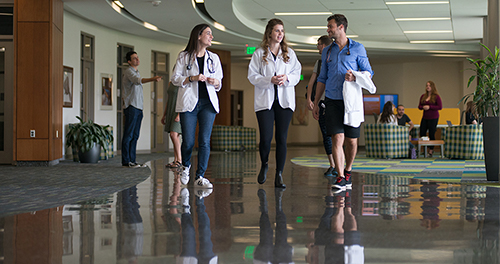
For aspiring physicians, navigating the rigors of medical school can, at times, feel immense and complex.
That reality was not lost on leaders at WMed, who have forged a curriculum that boasts an intentional focus on the student and a delivery that is personal and adaptable for each learner.
This is especially evident for first- and second-year students during Foundations of Medicine, which features a decompressed curriculum with a total of 14 weeks spread over 20 months for vacation, electives, or time for remediation between courses.
“The decompressed nature of our curriculum at WMed allows for more individual experiences through M1 and M2 electives during green weeks,” said Michael Busha, MD, MBA, the medical school’s associate dean for Educational Affairs. “Students are able to use this time to make lots of connections both locally and elsewhere, and those relationships and introductions allow opportunities for students to then further their unique interests.”
Lisa Gustafson, a second-year student at WMed, said the medical school’s decompressed curriculum was one of the main things that drew her to Kalamazoo for her medical education. She said the weeklong breaks that are spread over the course of the first two years of medical school provide her and other students with more balance and differs from other medical students’ experience with a constant week-to-week grind followed by a summer break.
“I had friends in medical school who would grind, grind, grind and then over the summer do some sort of prolonged activity that was unrelated to the experiences they already had in school,” Gustafson said. “I didn't want that sort of choppiness in my experience.”
In September, during Common Read at WMed, Gustafson met Dr. Mona Hanna-Attisha, a physician and bestselling author who helped uncover the water crisis in Flint, Michigan, and is founder and director of the Michigan State University and Hurley Children’s Hospital Pediatric Public Health Initiative. Following that initial meeting, Gustafson spoke to Dr. Hanna-Attisha again at another event in Kalamazoo and told her she wanted to come to Flint to learn more about how the pediatric public health initiative in Flint worked.
Then, during a green week in February following the Behavioral Medicine course, Gustafson got the chance to spend a week in Flint with Dr. Hanna-Attisha and her team, and got a front-row seat to learn more about the different and broader aspects of the public health initiative.
“It was an incredible week,” Gustafson said. “It was cool to be the person to form that relationship.”
Gustafson said the week in Flint opened her eyes more to the ways that she can become involved in the Kalamazoo community while pursuing her medical education at WMed. For example, during the elective she learned about how the Pediatric Public Health Initiative and clinics in Flint partner with Dolly Parton’s Imagination Library to get books into the hands of children at an early age. The experience has prompted Gustafson to begin work with the literacy community in Kalamazoo to determine if – and how – children here can also benefit from the program.
“Outside of the elective opportunities, it is nice to be able to take a week after an intensive period of study to decompress and get your feet under you before the next block,” Gustafson said.
Dr. Busha said the medical school’s MD curriculum is nimble, responsive to student needs and adaptable. Those characteristics have been on full display, he said, as WMed transitioned to full virtual learning in the wake of the COVID-19 pandemic.
As the pandemic has unfolded, WMed leaders and faculty were able to quickly put in place a virtual platform for the delivery of lectures and clinical skills sessions “without compromising the delivery of the content, the rigor of the content, or the assessment that we expect in medical education,” Dr. Busha said.
“I think the design of our curriculum was well-constructed to make these kinds of transitions in design and structure, and the fact that we were already personalized and nimble made it easier for us to easily set up the ways we deliver,” he added.
Dr. Busha said faculty have pushed ahead with live lectures and virtual office hours using tools such as Microsoft Teams. They’ve also strived to make sure students feel connected and have structured labs and clinical skills sessions so that students don’t feel like they’re receiving the virtual instruction alone.
“I’ve been really impressed and our faculty are driven to make sure that our students don’t feel disconnected,” Dr. Busha said. “Faculty have been very proactive in making sure we have an engaged student body.”
